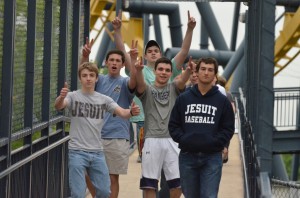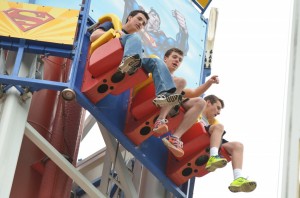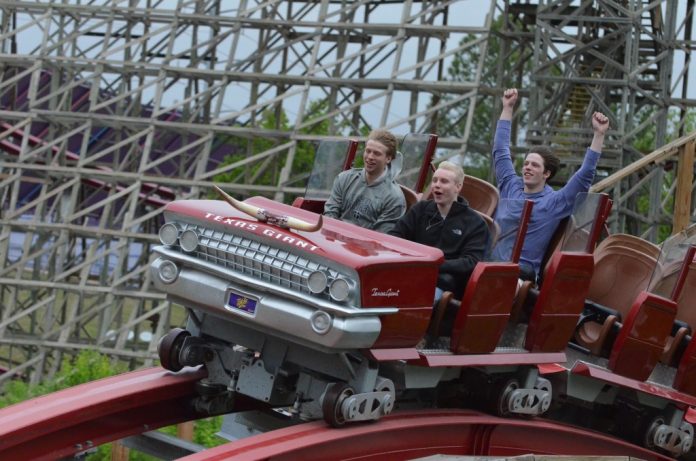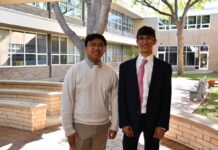“Roller coasters and physics are a match made in heaven,” declared Patrick Finegan ’14, AP Physics student and roller coaster enthusiast. This day was no ordinary day for the Jesuit physics students. Unlike the balloon propeller lab and the Rube Goldberg project, this 2013 Physics Day on Friday, April 26 brought a whole new level of excitement: roller coasters.
Having performed with excellence throughout the 2012-2013 school year, the junior and senior physics students looked toward this Friday with much anticipation. However, the magical journey to Six Flags was not offered to just any student; only the high-achieving, mathematically and scientifically driven “A” students of regular physics and AP physics students could embark on such an adventure.
Upon arriving, the students were confronted with about only twenty other visitors, thus leaving the lines to a 5 minute maximum. Diego Gutierrez-Tomlinson ‘14 describes the small lines as the “best part” of the amusement park and said that they brought this surprising sense of “comfort” in a place where anxiety and impatience is commonplace.
The shift in environment was a “nice change from the classroom because [the students] got to learn in an exciting atmosphere,” said Christopher Wolff ’14. It really was a transition from the “passive” classroom environment to an “active, exciting” one.
After entering this enchanting kingdom, the students were handed pink worksheets with simple physics-related problems to complete throughout the trip. These problems required the students to apply their superior physics skills and record data on roller coasters. As explained by Jason Tabet ’14, the “lab” should never be a reason to “not go to physics day,” but instead to get “something educational” out of it.
 After three hours of blacking out, losing their voices, and filling their stomachs with butterflies of anxiety, the Jesuit physics students attacked the food courts. Split up throughout the park, the students stormed burger joints, dippin’ dots, turkey legs, corn dogs, funnel cakes, and other delectable, carb-enriched treats in the amusement park. After eating a double cheeseburger, a chocolate shake, and onion rings, Matt Siess ’14 remarked that “it was quite a relief to ride the Batwing after lunch,” referring to it as a “warm-up” for the greater rides to come.
After three hours of blacking out, losing their voices, and filling their stomachs with butterflies of anxiety, the Jesuit physics students attacked the food courts. Split up throughout the park, the students stormed burger joints, dippin’ dots, turkey legs, corn dogs, funnel cakes, and other delectable, carb-enriched treats in the amusement park. After eating a double cheeseburger, a chocolate shake, and onion rings, Matt Siess ’14 remarked that “it was quite a relief to ride the Batwing after lunch,” referring to it as a “warm-up” for the greater rides to come.
Within the Jesuit students were a few inexperienced rookies to the thrilling world of roller coasters. One of these beginners was Will Farrell ’14. His heart pounding and his eyes widening, Will charged Six Flags with only one goal: to ride every single ride, and he did just that. At the sound of the first tickets being scanned in, Will sprinted to the steepest ride of Six Flags: The Texas Giant. Rising up to fourteen stories, or 153 feet, the enormous Texas Giant with a record-breaking drop of 95°, steeper than any other wooden coaster on the planet, welcomed Will immediately. Whereas myself and a few other students began our journey with a few rounds on the classic Sombrero ride, Will kept his eyes steadfast on the Giant and took it on with vigor. Returning with his mouth dried and hair messed up, Will describes the ride up the monstrous uphill as “nerve-racking,” but enjoyed the “rush” of excitement in diving down the slope with his friends. After the Giant, Will tackled every other ride in the park with bravery and determination.
the Giant, Will tackled every other ride in the park with bravery and determination.
This Six Flags trip was an exhilarating trip for both the students and the teachers. Mr. Von Schlehenried and Ms. Clayton, junior and senior physics teachers, found much excitement particularly in riding the Texas Titan and Runaway Mountain, two of Ms. Clayton’s favorites. Shouldn’t the teachers also have fun sometimes?
For upcoming juniors: if you want to experience the exhilarating, breathtaking, and thrilling day of roller coasters on Six Flags Day, work hard in your physics class and you will be rewarded with the most eventful physics class you will ever experience! After all, as Diego explains, one should “not only go for the ride, but [also] try to learn physics.”






